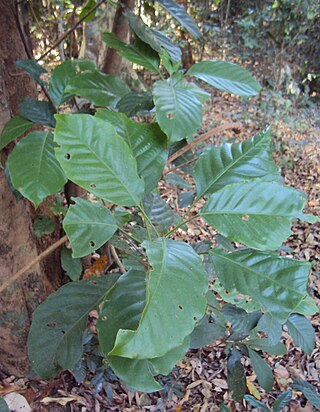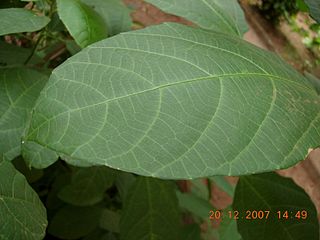
Antidesma is a genus of tropical plant in the family Phyllanthaceae formally described by Linnaeus in 1753. It is native to tropical Africa, S + E + SE Asia, Australia, and various oceanic islands. The greatest diversity occurs in Southeast Asia.

Mallotus is a genus of the spurge family Euphorbiaceae first described as a genus in 1790. Two species are found in tropical Africa and Madagascar, while all others are found in East Asia, the Indian Subcontinent, Southeast Asia, eastern Australia, and certain islands of the western Pacific. The genus has about 150 species of dioecious trees or shrubs.

Trigonostemon is a plant genus of the family Euphorbiaceae and the sole member of its tribe (Trigonostemoneae). It was first described as a genus in 1826. It is native to Southeast Asia, southern China, the Indian Subcontinent, Queensland, and a few islands in the western Pacific.

Paracroton is a genus of flowering plants in the Euphorbiaceae first described as a genus in 1859. It is native to South and Southeast Asia, as well as New Guinea.
- Paracroton integrifolius(Airy Shaw) N.P.Balakr. & Chakr. - Kerala, Tamil Nadu
- Paracroton pendulus(Hassk.) Miq. - India, Sri Lanka, Myanmar, Thailand, Malaysia, Borneo, Sumatra, Philippines
- Paracroton sterrhopodus(Airy Shaw) Radcl.-Sm. & Govaerts - W New Guinea
- Paracroton zeylanicus(Müll.Arg.) N.P.Balakr. & Chakr. - Sri Lanka
Spathiostemon is a genus of trees in the Euphorbiaceae family. It is native to the Bismarck Archipelago, New Guinea, Wallacea and Southeast Asia. The trees grow between 10 and 20m tall, often in secondary forest. The wood is sometimes used.

Sumbaviopsis is a genus of plants in the family Euphorbiaceae first described as a genus in 1910. It contains only one known species, Sumbaviopsis albicans, native to Yunnan, the eastern Himalayas, and Southeast Asia.
Cnesmone is a genus of plant of the family Euphorbiaceae first described as a genus in 1826. It is native to southern China and to much of Southeast Asia.

Blumeodendron is a genus of dioecious trees of the family Euphorbiaceae first described as a genus in 1873. It is widespread across much of Southeast Asia and Papuasia.
Tapoides is a monotypic plant genus in the family Euphorbiaceae. The sole species is Tapoides villamilii. It is endemic to Borneo. It is dioecious, with male and female flowers on separate plants.

Baliospermum is a genus of plants under the family Euphorbiaceae first described as a genus in 1825. It is native to Southeast Asia and the Himalayas.

Tritaxis is a genus of plants under the family Euphorbiaceae first described as a genus in 1858. It is native to Southeast Asia, including parts of India, Sri Lanka, China Hainan, else into Philippines New Guinea, and Northern Australia (Queensland). Until recently, many species were listed under the genus Dimorphocalyx, first described as a genus several years later in 1861.

Bischofia is a genus of plants in the family Phyllanthaceae first described as a genus in 1827. It is native to southern China, the Indian Subcontinent, Queensland, New Guinea, and various islands of the Pacific. It is the only member of the tribe Bischofieae. They are dioecious, with male and female flowers on separate plants, but may rarely be monoecious.

Bridelia is a genus of plants in the family Phyllanthaceae first described as a genus in 1806. It is widespread across Africa, Australia, southern Asia, and various islands of the Indian and Pacific Oceans.

Daphniphyllum is the sole genus in the flowering plant family Daphniphyllaceae and was described as a genus in 1826. The genus includes evergreen shrubs and trees mainly native to east and southeast Asia, but also found in the Indian Subcontinent and New Guinea.

Chionanthus, common name: fringetrees, is a genus of about 140 species of flowering plants in the family Oleaceae.
Paracroton zeylanicus is a species of flowering plant in the family Euphorbiaceae that is endemic to south-western parts of Sri Lanka. It was first found from a Hinidumkanda Biosphere Reserve, but rapidly declined due to deforestation and other anthropogenic activities. The plant is listed as a critically endangered by IUCN.

Trichoglottis, commonly known as cherub orchids or 毛舌兰属 , is a genus of flowering plants in the family Orchidaceae. Orchids in this genus are epiphytic plants with thick roots, relatively thick, fibrous stems and many large, thick, leathery leaves arranged in two ranks. The flowers are usually small and yellowish with light brown or purple markings. The flowers have broad sepals, narrower petals and a labellum which has three lobes and is often hairy. There are about 85 species distributed from tropical and subtropical Asia to the north-western Pacific. Most species grow in rainforest.

Tupistra is a genus of about 20 species of flowering plants found in south Asia, from southern China to Sumatra and Ambon Island. In the APG III classification system, it is placed in the family Asparagaceae, subfamily Nolinoideae.

Lepionurus is a genus of plants in the family Opiliaceae described as a genus in 1826.

Paracroton pendulus is a species of flowering plant in the family Euphorbiaceae that is endemic to Western Ghats of India and Sri Lanka.
















